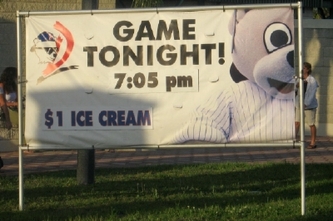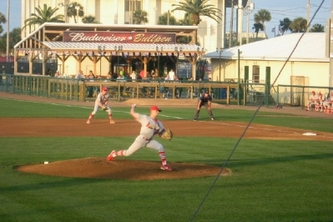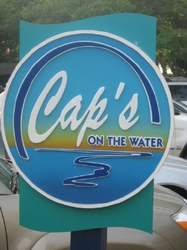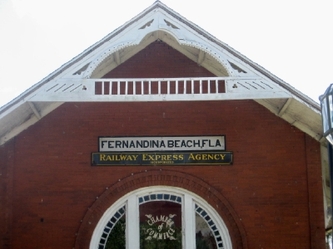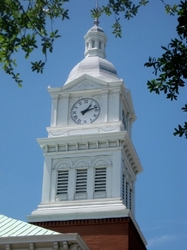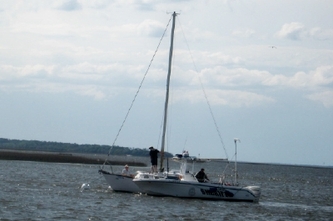
Entering Key Biscayne by the Cape Florida light
Well, we’ve come as far north in Florida as we can go – Fernandina Beach-- but we still don’t want to do Georgia on the inside. So, we’re waiting for a weather window to go straight to Charleston on the outside. One side benefit of waiting is that we’re likely to see Pat and Fred who are due to arrive in Fernandina on the 16th.
We’re leaving . . . now?
As we went to bed Monday night the 31st of March, we had resigned ourselves to at least 1 more day in Marathon. We weren’t seeing the weather to leave on the 1st even though everything else about Orion and her crew was ready to go. But Dave was up early checking the weather on Tuesday, when he said to Cathy, I think we should go. Go? Now? It was about 8am already and we needed to get to Rodriguez Key, about a 50 mile trip. We still had to make a run to shore, get the dinghy stowed and strip off the solar panels in order to get underway. That meant we would get underway by 9am if we were lucky. There wasn’t even time to let Slow Dancin’ or Fortunate know of our sudden decision.
Dave ran ashore and Cathy readied the boat for getting underway. When he returned and we were hauling the dinghy, Rusty from Slow Dancin’ buzzed over in his dinghy to confirm the obvious and say goodbye. We wished each other well and promised to look for the other up the waterway. Similarly, we waved goodbye to Barb and Dave and Fortunate and headed out for the bridge and the Hawk Channel. After the bridge tender urged us to visit again, we made our way to the turn east up the channel between the outer reef and the Keys. This was going to be the worst part of the trip, a slog into 20 knot east winds and 2-4 seas. It’s not weather we would normally have picked, but the promise of calmer weather and more favorable winds as the day progressed – and the grandbaby at the end of all this – made it worth the uncomfortable ride early on. (At one point, some of the unstowed items still in the cockpit rattled loose, and our dinghy light slid overboard before we could even react.) Sure enough, as we turned to a more northerly course, we had moderating winds and the right angle to motorsail the last 10 miles to Rodriguez Key.
We’re leaving . . . now?
As we went to bed Monday night the 31st of March, we had resigned ourselves to at least 1 more day in Marathon. We weren’t seeing the weather to leave on the 1st even though everything else about Orion and her crew was ready to go. But Dave was up early checking the weather on Tuesday, when he said to Cathy, I think we should go. Go? Now? It was about 8am already and we needed to get to Rodriguez Key, about a 50 mile trip. We still had to make a run to shore, get the dinghy stowed and strip off the solar panels in order to get underway. That meant we would get underway by 9am if we were lucky. There wasn’t even time to let Slow Dancin’ or Fortunate know of our sudden decision.
Dave ran ashore and Cathy readied the boat for getting underway. When he returned and we were hauling the dinghy, Rusty from Slow Dancin’ buzzed over in his dinghy to confirm the obvious and say goodbye. We wished each other well and promised to look for the other up the waterway. Similarly, we waved goodbye to Barb and Dave and Fortunate and headed out for the bridge and the Hawk Channel. After the bridge tender urged us to visit again, we made our way to the turn east up the channel between the outer reef and the Keys. This was going to be the worst part of the trip, a slog into 20 knot east winds and 2-4 seas. It’s not weather we would normally have picked, but the promise of calmer weather and more favorable winds as the day progressed – and the grandbaby at the end of all this – made it worth the uncomfortable ride early on. (At one point, some of the unstowed items still in the cockpit rattled loose, and our dinghy light slid overboard before we could even react.) Sure enough, as we turned to a more northerly course, we had moderating winds and the right angle to motorsail the last 10 miles to Rodriguez Key.
The next day’s conditions made the slog out of Marathon worth it. We barely motored at all, sailing all the way from Rodriguez Key to Key Biscayne. We even considered going on to Fort Lauderdale or Lake Worth, but once outside the protection of the reef, the waves were building and the clouds were looking more ominous than forecasts were saying they should. So we tucked into the Biscayne Bay via “Stiltsville”, the inlet so named for the houses on stilts that line each side.
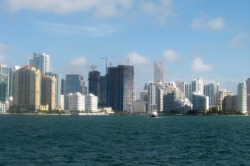
Miami skyline from the ICW
Finding the Gulf Stream
We got a late start on Thursday out of Key Biscayne. The weather forecast gave us some concern, but since Fort Lauderdale was a relatively short run, and we could do the first 10 miles on the ICW, we decided to poke our heads out and give it a try. On the off chance that we might find the right conditions to keep going, Cathy went down below for a nap to try to get us on a pattern for an overnight.
We got a late start on Thursday out of Key Biscayne. The weather forecast gave us some concern, but since Fort Lauderdale was a relatively short run, and we could do the first 10 miles on the ICW, we decided to poke our heads out and give it a try. On the off chance that we might find the right conditions to keep going, Cathy went down below for a nap to try to get us on a pattern for an overnight.
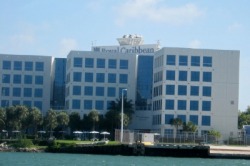
Cruise Line offices on Fishermans Channel
However, once in the Miami inlet, any thought of napping was literally tossed aside. Orion was slamming into the waves that were being built by the east wind opposing the ebbing tide. As Dave angled north to ease the impact a little, the angle on the beam caused the boat to rock everything loose down below and up in the cockpit. The swim shower rolled end over end and fell out of the cockpit to the floor at the bottom of the companionway stairs. Cathy was scrambling around below trying to stow things more securely without becoming another victim in the process. She finally poked her head out on deck to see what was causing the ruckus below.
We were making our way out of the inlet, having turned well before the sea buoy, to get a few miles offshore, with the hopes of picking up the northerly Gulf Stream current. NOAA had reported it only 8 miles off Fort Lauderdale. Within 3 miles of shore, we were already seeing 10 knots of speed. Orion doesn’t go 10 knots under power. We decided to put out a furled headsail and kill the engine. We were still making better than 8.5 knots. The waves had moderated since leaving the inlet. Although we were still getting rocked a bit, it was more manageable. It didn’t take us long to start doing some math. At 8 knots, even with our late departure, we could actually make it to Lake Worth before dark. That would gain us a full day of travel north. Since the Gulf Stream was supposed to be even closer to shore at Lake Worth, it seemed achievable.
Sure enough, the current stayed with us up the coast, and we had our anchor set by 7:30 in the Lake Worth anchorage, having done in 10 hours, what had taken 14 to do in reverse.
Don’t you love the Gulf Stream.
We were making our way out of the inlet, having turned well before the sea buoy, to get a few miles offshore, with the hopes of picking up the northerly Gulf Stream current. NOAA had reported it only 8 miles off Fort Lauderdale. Within 3 miles of shore, we were already seeing 10 knots of speed. Orion doesn’t go 10 knots under power. We decided to put out a furled headsail and kill the engine. We were still making better than 8.5 knots. The waves had moderated since leaving the inlet. Although we were still getting rocked a bit, it was more manageable. It didn’t take us long to start doing some math. At 8 knots, even with our late departure, we could actually make it to Lake Worth before dark. That would gain us a full day of travel north. Since the Gulf Stream was supposed to be even closer to shore at Lake Worth, it seemed achievable.
Sure enough, the current stayed with us up the coast, and we had our anchor set by 7:30 in the Lake Worth anchorage, having done in 10 hours, what had taken 14 to do in reverse.
Don’t you love the Gulf Stream.
Paragraph.

Sunrise over ocean off Lake Worth
If It's Friday, It Must Be Vero Beach
So, what was next? We had continued to listen to the forecast, and the winds were supposed to be less intense on Friday, so a run outside from Lake Worth to Fort Pierce seemed reasonable, assuming we were up before dawn, not like yesterday. At this point, the Gulf Stream and the Florida coast diverge, so we wouldn’t get the favorable currents on this trip. Instead, we did a modest 5.5 knots under the headsail as we moved north along the coast. As we traveled, we listened to the boats on the VHF doing the inside run, navigating all 8 opening bridges. We didn’t miss it at all. What surprised us was the conversations about 25 knot winds. We weren’t seeing anything like that. Hmmm ….
At about 3pm we were making for the Fort Pierce sea buoy, when we started realizing the southeast winds that had been helping us along, were going to make for a wicked run up the inlet. The winds were also increasing as we headed for shore, which was unusual. Dave carefully lined up for the inlet, trying to stay to port to offset the effect of the waves. As we got heeled over with each wave, we tried to make out the boat traffic ahead of us. We couldn’t believe it, but a sailboat was heading out the inlet. Were they crazy? This would make it a little more interesting. Dave was having trouble reading their progress as they first lined up for a starboard to starboard pass, and then starting turning to port, which put them right on our path. It took us a few seconds to realize that they were turning around. Smart move. I guess they realized it wasn’t going to be worth it.
So, what was next? We had continued to listen to the forecast, and the winds were supposed to be less intense on Friday, so a run outside from Lake Worth to Fort Pierce seemed reasonable, assuming we were up before dawn, not like yesterday. At this point, the Gulf Stream and the Florida coast diverge, so we wouldn’t get the favorable currents on this trip. Instead, we did a modest 5.5 knots under the headsail as we moved north along the coast. As we traveled, we listened to the boats on the VHF doing the inside run, navigating all 8 opening bridges. We didn’t miss it at all. What surprised us was the conversations about 25 knot winds. We weren’t seeing anything like that. Hmmm ….
At about 3pm we were making for the Fort Pierce sea buoy, when we started realizing the southeast winds that had been helping us along, were going to make for a wicked run up the inlet. The winds were also increasing as we headed for shore, which was unusual. Dave carefully lined up for the inlet, trying to stay to port to offset the effect of the waves. As we got heeled over with each wave, we tried to make out the boat traffic ahead of us. We couldn’t believe it, but a sailboat was heading out the inlet. Were they crazy? This would make it a little more interesting. Dave was having trouble reading their progress as they first lined up for a starboard to starboard pass, and then starting turning to port, which put them right on our path. It took us a few seconds to realize that they were turning around. Smart move. I guess they realized it wasn’t going to be worth it.

Stowaways on deck
After another 12 miles up the ICW (and 1 opening bridge), we came into Vero and had the joy of rafting to another unattended boat in 25 knot winds. We don’t recommend this to anyone. As Cathy and Dave scurried up and down the deck, there was something squishing beneath our feet. To her horror, Cathy looked down and realized there were about a dozen dead fish on the deck. She had been stepping on them in the haste of fending off the boats. Ugh! They were flying fish that jumped aboard on the outside run.
It's always something.
Inside or Out?
We decided to wait out a few stormy days in Vero, which included some violent thunderstorms. On Saturday, we visited with the couple on Pearl, whom we had met in Marathon and their friends on Freedonia. They arrived the day after we did, having made a longer outside run to Fort Pierce from Marathon. Finally, we decided it was time to move on, but that we weren’t going to get the wind to travel outside. So we committed to an inside run up to Fernandina Beach. We still had hopes of connecting to Pat and Fred, who were likely to come in at Cape Canaveral. That meant we had to get north of them.
It's always something.
Inside or Out?
We decided to wait out a few stormy days in Vero, which included some violent thunderstorms. On Saturday, we visited with the couple on Pearl, whom we had met in Marathon and their friends on Freedonia. They arrived the day after we did, having made a longer outside run to Fort Pierce from Marathon. Finally, we decided it was time to move on, but that we weren’t going to get the wind to travel outside. So we committed to an inside run up to Fernandina Beach. We still had hopes of connecting to Pat and Fred, who were likely to come in at Cape Canaveral. That meant we had to get north of them.

NASA's Haulover Canal bridge on the way to Mosquito Lagoon.
We made a long day’s trip to Titusville on Tuesday (April 8) and then a shorter day on Wednesday to Daytona Beach. Tuesday just had a lot of strong winds on the nose. But Wednesday was going to take us through both shallow water before the New Smyrna bridge and Ponce Inlet, where numerous boats had gone aground in the fall. We wanted to hit this at high tide. We called BoatUS in Daytona Beach and they said that a dredge was working in the inlet, but that going through at high tide, we should be fine. They also said to avoid the shallow water near New Smyrna that we should take Sheephead Cut. When we started listening to boats ahead of us on Wednesday, BoatUS had a different take about the inlet. They initially were advising boats to go through the inlet, not the ICW. Then the Coast Guard said some buoys were off station in the inlet. We called BoatUS for clarification and they actually rode through both the inlet and the ICW to check them out. Their final recommendation was: take the ICW.

Sheephead Cut’s deep water was a welcome change
We took Sheephead Cut with lots of deep water and then made it to the ICW around Ponce Inlet right at high tide. We asked a trawler in front of us to let us know if they found any shallow water. By hugging the red marks, we were doing fine until we got close to the dredge near marker 6. The dredge was taking up the entire channel, which was forcing us out of the channel to get by. A sportfishing boat had already gone aground ahead of us. The captain of the dredge was waving us over to starboard. We got so close, we should have had fenders, but we didn’t go aground. The water depths dropped to 7 ½ feet and then started rising again. We made it out of the skinny water and breathed a sigh of relief.
We were glad to pull into our slip at Halifax Harbor. Hopefully, the worst was behind us. We got in early enough to take in yet another tour at Angell and Phelps chocolate factory and then went back to town for a minor league baseball game featuring the Daytona Cubs vs. Palm Beach that night.
We were glad to pull into our slip at Halifax Harbor. Hopefully, the worst was behind us. We got in early enough to take in yet another tour at Angell and Phelps chocolate factory and then went back to town for a minor league baseball game featuring the Daytona Cubs vs. Palm Beach that night.
Daytona to Fernandina
We left early on Thursday for St. Augustine, the first in a long line of sailboats at the opening bridge just outside the marina. We quickly increased the distance between us, so we would not have to wait at each opening bridge for a fleet of sailboats. We did enjoy talking to the other sailboats – Smiles, Hananiah, Oz, Cygnet -- exchanging information about the waterway and weather forecasts as we moved along. We passed through St. Augustine and made it upriver to Cap’s Seafood Restaurant, where we tied up for the night. It was a much busier place than in the fall, but the food was just as good. We helped several other smaller boats dock and cast off before putting in for the night. It’s a great stop.
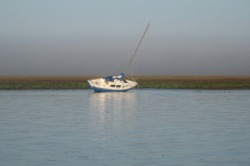
Traveling at low water most of the day from St. Augustine to Fernandina, we were glad to avoid this boat’s fate.
On Friday, we headed out with warnings of fog, that closed in within a few miles after we set out. It was never so thick that we couldn’t pick out the next mark or nearby boats, but it did require more concentration. With the current against us the entire run, we made slower progress, but arrived in Fernandina around 4pm on a mooring next to several of our traveling companions.
Fernandina to where?
Fernandina to where?
We still had hopes of making it to Charleston before leaving the boat to drive north to Virginia. However, the weather forecasts made that seem increasingly unlikely. Since we had a few days to watch the weather and since Pat and Fred were now in the US, having arrived in Cape Canaveral on Saturday, we decided to bide our time and wait for the weather – and Marianna – before making our next move. With any luck it will be Charleston.
In the meantime, we are enjoying Fernandina Beach, which is a lovely town to spend time in if you’ve got to be stuck somewhere.
In the meantime, we are enjoying Fernandina Beach, which is a lovely town to spend time in if you’ve got to be stuck somewhere.




